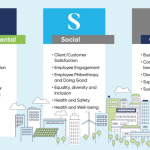
Developer Looks to Transform Last Privately-Owned Waterfront Site in Tacoma into “Iconic” Statement
Ship Lofts in The Registry PS
“Developer Looks to Transform Last Privately-Owned Waterfront Site in Tacoma into “Iconic” Statement” by Meghan Hall
Full Text:
As the Puget Sound grows, Tacoma is experiencing its own development boom, with property owners and commercial real estate firms planning projects that will impact the city’s skyline for years to come. However, the development team in charge of the last remaining privately owned waterfront parcel in Tacoma is taking a particularly bold approach: The project team for the Tacoma Ship Lofts intends to make the design almost controversial in an effort to make a statement.
“[The goal is] to create something extraordinary and iconic in that keystone location on the waterway,” explained David Grieshaber, founder of Eco Industrial House. “[The site] was the last privately held piece of property on the waterfront. It’s a pretty epic piece of property, and it deserves a building that stands out. Tacoma deserves something on that property that will do it justice.”
The existing 1.29-acre lot is located at 1179 Dock Street, and is elongated and included an old dock structure. Currently, the property is being used as a parking lot and has watched the revitalization of downtown Tacoma’s waterfront take shape as it awaited redevelopment itself. Prior to its use as a parking lot, the property was used for more than 110 years as the home of the Colonial Fruit and Produce company, previously known as Pacific Fruit and Produce.
The building will rise five stories, and the units will be either one- or two-bedrooms. The condos will range in size from about 1,000 to 3,500 square feet. 26 parking spaces, as well as three, 570 square feet commercial and retail spaces–created from converted cargo containers–are currently part of the plans. The lofts will also feature live/work capabilities, with large floor plans and minimalist designs.
At the roof level, a “wheelhouse” will allow residents to host gatherings, while full length balconies will wrap all lofts. Residents will also have access to a chef’s kitchen and pantry room with wine storage, as well as guest and customer mooring.
The project, inspired by Tacoma’s history and position on the Thea Foss Waterway, will be a “mash-up” of a cargo ship, cruise liner, and mega yacht in its design. Its design will seek to tie together the bridges on both sides of the site, local art museums, as well as the region’s shipping industry.

The building will artistically use mass timber and natural materials such as steel, concrete, glass and cargo containers to carve its exterior. Blackened steel takes inspiration from steel ahuls and tar-coated hauls, while the interior will showcase wood craftsmanship–an ode to local sawmills and boat construction. The building will also be outfitted with salvaged and nautical ship-related items, including portals, lights, and an anchor.
Grieshaber believes that the project’s design will be a conversation starter: People will either “love it or hate it.” However, because the development will be targeting tech-oriented and well-off consumers who are looking for high-quality and unique living options,, the project team believes there is leeway for creativity.
“When you have 300 units to sell, you have to go to the general masses; you have no choice in that,” acknowledged Grieshaber. “But when you have 31 units to sell, you can be selective. Passion projects…those are the ones that people talk about. Those are the ones that make the news.”
Grieshaber believes that the development’s unique design will only help it to sell. Ultimately, the goal of the project team is to steer clear of “cookie cutter” and “look-alike ultra-dense multifamily housing,” the likes of which have become increasingly common amidst Tacoma’s development boom. Grieshaber estimates that the number of permitted developments in the pipeline has risen about 45 percent over the past year. Many of these buildings are clad in industrial materials or are “boxy” in shape with little interest in modulation. The Ship Lofts project hopes to change the name of the game.
Many of these projects are cropping up as a result of Seattle and rapidly expanding suburbs on the Eastside. Now, developers are turning their sites south in order to snap up extra space.
“From my view, I come from the San Francisco Bay Area, and I saw the tech industry grow from Silicon Valley to San Francisco,” said Grieshaber. “Then when San Francisco filled up, everyone outflowed..The same thing is happening here but at a slower pace.”
The project is making steady progress, with the property under contract for development. Grieshaber is also currently working to put together a “world renowned” architecture team to refine the design of the project and help see it through the entitlements process. While timing of the project depends not only on entitlements–but funding and the procurement of a joint venture partner–Grieshaber estimates the project can be completed in about 36 months.
Thus far, feedback from contractors–and potential buyers–has been strong.
Grieshaber noted, “Every group involved so far wants to make this a showcase.”


